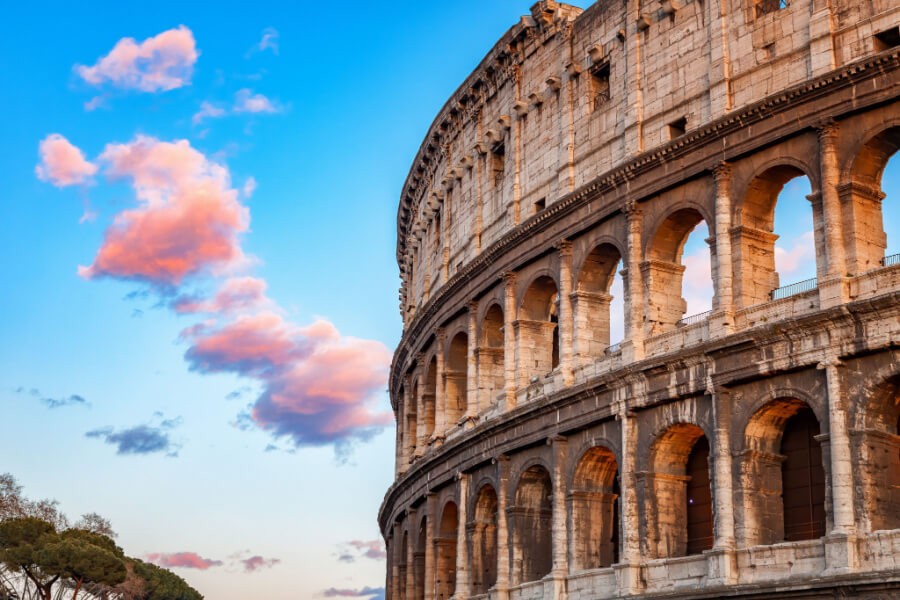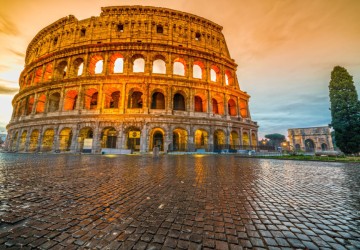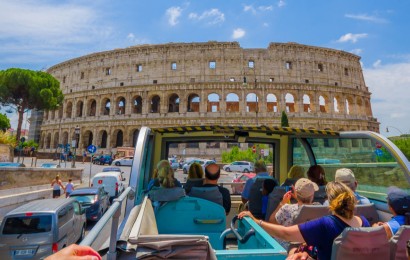The Colosseum is the most famous monument in Rome and a must-see. Its history fascinates and intrigues tourists from all over the world.
→ If you want to discover the beauty and glory of ancient Rome, you can book our guided tour of the Colosseum and the Imperial Forums.
In our article you will discover when the Roman Coliseum was built, its history, functions and some curiosities.
History of the Roman Colosseum
The Colosseum of Rome (also known as the Flavian Amphitheatre) is the largest Roman amphitheatre in the world and the most impressive monument in the history of ancient Rome.
In 1980 it was included in the list of UNESCO World Heritage Sites and in 2007 it was included among the New Seven Wonders of the World.
When was the Roman Colosseum built?
The construction of the Colosseum in Rome is due to the emperor Vespasian in 70 -72 A.D. (during the Flavian dynasty) and was completed by his son Titus in 80 A.D.
The construction work was financed with the proceeds of provincial taxes and the loot of the Temple of Jerusalem.
In 1813 a block of marble with a dedicatory inscription was found:
«I[MP(ERATOR)] CAES(AR) VESPASI[ANUS AUG(USTUS)] AMPHITEATRU[M NOVUM] [EX] MANUB(I)S [FIERI IUSSIT]»
Which translates to mean:
«The emperor Cesare Vespasiano Augusto had the new amphitheatre built with the proceeds of the booty.»
It was chosen as an area a valley between the Velia, the Oppio and the Celio, where there was an artificial lake excavated by Nero for his Domus Aurea, his residence.
The aqueduct was diverted for civil use, the lake was bonfied and the foundations were laid there.
Before his death (in 79), Vespasian saw the construction of the first two floors. It was Titus (son of Vespasian) who added the third and fourth order of seats and inaugurated the construction of the Colosseum, on April 21, 1980, with a hundred days of games.
The amphitheatre ceased to perform its original function in the sixth century AD.
Over the centuries its arches housed artisans, workshops, hospitals, brotherhoods and even a cemetery.
The popes instead used it as a marble and travertine quarry to build Palazzo Barberini, the Capitol, Palazzo Venezia and San Pietro.
→ At stop 3 of our panoramic tour of Rome "Hop on Hop Off" you will find the Colosseum and you can also visit the archaeological area, the Roman Forum, the Palatine and the Arch of Constantine.
Curiosities about the Colosseum

Here are some answers to the most common curiosities about the Colosseum in Rome:
- Why is the Colosseum broken?
Its shape is due to a disastrous earthquake that occurred in 1349 with epicenter in the Central Apennines, which destroyed a part, making it asymmetric. Not everyone knows, however, that the ancient structure of the amphitheater collapsed only half, because of the earthquake on which it rests.
The southern part of the Colosseum, the one affected by the collapse, is located on a soft subsoil made up of river sediments. In fact, here there was a semi-artificial lake, which fed by an ancient tributary of the Tiber, was placed in the center of the gardens of the Domus Aurea, DI Nerone.
The northern part of the Colosseum rests instead on a soil of volcanic rocks much more resistant and that have preserved that part of buildings; - Who owns the Colosseum?
The Colosseum is a property in the hands of the Archaeological Park of the Colosseum and is directly managed and protected by it; - How many people were killed in the Colosseum?
Within the Colosseum almost 500,000 gladiators and one million animals died; - Is the colosseum or the Arena of Verona bigger?
Compared to the Colosseum, the Verona Arena is less than half the size. In the Arena were held and still held shows of all kinds, especially the musical ones;
- What did the Romans do in the Colosseum?
The Romans went inside the Colosseum to witness gladiatorial fights (milkera), the killing of convicts by ferocious animals or other types of public executions (noxii), animal fights (venationes) and other public demonstrations. They were represented, in fact, hunting shows, re-enactments of famous battles (naumachie), and dramas based on classical mythology; - Who built the Colosseum?
The Colosseum was built at the behest of the Emperor Vespasian in 72 AD.
In addition to curiosity, there are also legends related to the great Roman amphitheater. According to some myths of the Middle Ages it seems that the Colosseum represents the entrance to hell where, at sunset, the souls of the dead wander in search of eternal peace.
Another curious legend says that the Coliseum was a kind of diabolical temple in which sorcerers addressed the following question to the followers: "Colis Eum?" which means "Adore Him?" in reference to the devil. Hence the name Coliseum
Moreover, many people wonder what were the countless holes that dot the structure of the Colosseum. According to popular tradition these were the attempt of the barbarians to destroy the amphitheater. When the invaders conquered the city, they made holes in the wall and filled them with gunpowder in order to blow up the famous monument. An unnecessary effort, because the foundations held and the Colosseum remained standing. Hence the Roman saying: "As long as the Colosseum lasts, so will Rome!"

